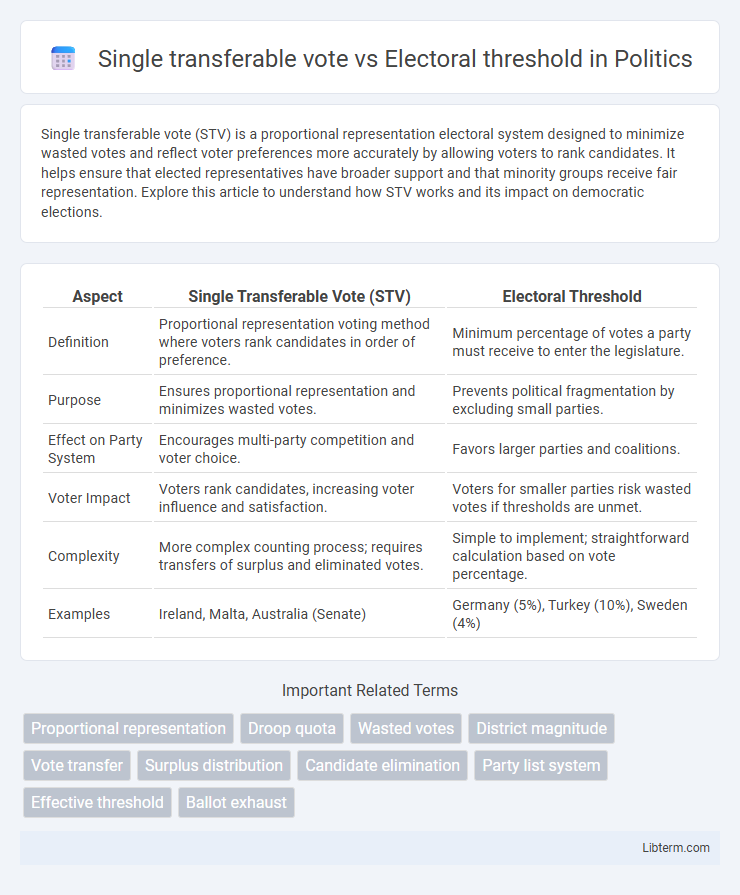Single transferable vote (STV) is a proportional representation electoral system designed to minimize wasted votes and reflect voter preferences more accurately by allowing voters to rank candidates. It helps ensure that elected representatives have broader support and that minority groups receive fair representation. Explore this article to understand how STV works and its impact on democratic elections.
Table of Comparison
| Aspect | Single Transferable Vote (STV) | Electoral Threshold |
|---|---|---|
| Definition | Proportional representation voting method where voters rank candidates in order of preference. | Minimum percentage of votes a party must receive to enter the legislature. |
| Purpose | Ensures proportional representation and minimizes wasted votes. | Prevents political fragmentation by excluding small parties. |
| Effect on Party System | Encourages multi-party competition and voter choice. | Favors larger parties and coalitions. |
| Voter Impact | Voters rank candidates, increasing voter influence and satisfaction. | Voters for smaller parties risk wasted votes if thresholds are unmet. |
| Complexity | More complex counting process; requires transfers of surplus and eliminated votes. | Simple to implement; straightforward calculation based on vote percentage. |
| Examples | Ireland, Malta, Australia (Senate) | Germany (5%), Turkey (10%), Sweden (4%) |
Introduction to Voting Systems
The Single Transferable Vote (STV) system allows voters to rank candidates in order of preference, promoting proportional representation and minimizing wasted votes. Electoral thresholds set a minimum percentage of votes a party must receive to gain seats, preventing fragmentation but potentially excluding smaller parties. Both mechanisms influence parliamentary representation and voter influence within proportional and mixed electoral systems.
What is the Single Transferable Vote (STV)?
The Single Transferable Vote (STV) is a proportional representation electoral system designed to minimize wasted votes by allowing voters to rank candidates in order of preference. Candidates must reach a specific quota of votes to be elected, with surplus votes transferred according to voter preferences until all seats are filled. Unlike systems with an electoral threshold, which require parties to achieve a minimum percentage of votes to enter a legislature, STV emphasizes individual candidate selection and proportionality without fixed vote cut-offs.
Understanding Electoral Thresholds
Electoral thresholds set a minimum percentage of votes that parties must achieve to gain representation in a legislature, preventing fragmentation and promoting governability. The Single Transferable Vote (STV) system bypasses strict thresholds by allowing voters to rank candidates, enabling votes to transfer and better reflect voter preferences. Understanding electoral thresholds is crucial for evaluating how STV provides more proportional representation compared to traditional blocked-list systems with fixed vote cutoffs.
How STV Works in Practice
The Single Transferable Vote (STV) system allows voters to rank candidates by preference, ensuring proportional representation by transferring votes from eliminated or surplus candidates to others based on these rankings. This method minimizes wasted votes, unlike the Electoral Threshold system, which requires a party to achieve a minimum percentage of votes to gain seats, often excluding smaller parties. In practice, STV promotes broader voter choice and more accurate reflection of voter preferences across multi-member constituencies.
Purpose and Impact of Electoral Thresholds
Electoral thresholds are designed to prevent excessive party fragmentation by setting a minimum vote percentage that parties must achieve to gain representation, thus promoting political stability and governability. Unlike the single transferable vote (STV) system, which emphasizes proportionality and voter choice through ranked preferences, electoral thresholds limit representation to larger parties, potentially excluding smaller or emerging groups. This exclusion can lead to wasted votes but aims to avoid legislative gridlock caused by highly fragmented party systems.
Advantages of the Single Transferable Vote
The Single Transferable Vote (STV) system enhances proportional representation by allowing voters to rank candidates in order of preference, reducing wasted votes and ensuring minority voices gain fair representation. STV minimizes the impact of electoral thresholds, which often exclude smaller parties, by enabling vote transfers that help candidates reach necessary quotas for election. This system promotes voter choice and accurate reflection of diverse political opinions within multi-member constituencies, leading to more inclusive and representative governance.
Pros and Cons of Electoral Thresholds
Electoral thresholds prevent political fragmentation by excluding parties with minimal support, promoting stable governance and clearer policy mandates. However, high thresholds can disenfranchise smaller parties and minority groups, limiting political diversity and reducing proportionality in representation. Balancing the threshold level is crucial to ensuring both effective government formation and fair voter representation.
Comparing Representation Outcomes
Single transferable vote (STV) systems enable more proportional representation by allowing voters to rank candidates, leading to outcomes that reflect diverse voter preferences within multi-member districts. Electoral thresholds set minimum vote percentages parties must achieve to gain seats, which can exclude smaller parties and reduce overall proportionality in the legislature. Comparing representation outcomes, STV promotes inclusivity and minority representation, whereas electoral thresholds often result in a more consolidated party system with fewer but larger parties represented.
Case Studies: STV vs. Thresholds Worldwide
Case studies comparing Single Transferable Vote (STV) and electoral thresholds reveal distinct impacts on political representation and party diversity across global democracies. In Ireland and Malta, STV facilitates proportional representation by allowing voter preferences to transfer, reducing wasted votes and enabling smaller parties to gain seats. Conversely, countries with electoral thresholds, such as Germany and Turkey, use minimum vote percentages to enter parliament, which can stabilize governance but often limits the presence of minor parties and decreases proportionality.
Conclusion: Which System Promotes Fairer Representation?
The Single Transferable Vote (STV) system promotes fairer representation by enabling proportional allocation of seats based on voter preferences, reducing wasted votes and enhancing minority representation. Electoral thresholds, while designed to prevent fragmentation, often exclude smaller parties and limit diverse political voices, potentially skewing representation. Therefore, STV generally advances a more inclusive and accurate reflection of voter intent in legislative bodies.
Single transferable vote Infographic

 libterm.com
libterm.com